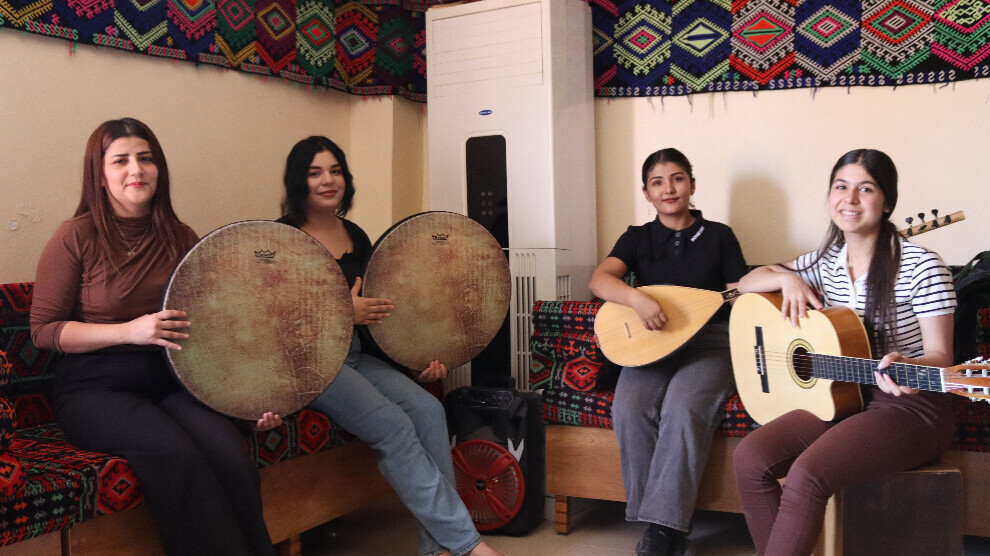A women's community centered around culture and art: Hîlala Zêrîn
At the Hîlala Zêrîn Women's Culture and Art Movement center in Kobanê, dozens of young women and children are forming a unique artistic community and reviving the culture of women and mothers.

BERÇEM CÛDÎ
Kobanê - Founded in 2016, the Hîlala Zêrîn Women's Culture and Art Movement in North and East Syria serves as a cultural, artistic, and literary umbrella for women in the region. Officially opened in 2018, the Hîlala Zêrîn Center in Kobanê is a center for women and children to learn, develop, and preserve their unique culture and art.
A women's unique and autonomous arts organization: Hîlala Zêrîn
The Hîlala Zêrîn Center is decorated with music and traditional instruments, cultural paintings, female statues, and flowers. Women are eager to learn all kinds of art, enabling them to preserve their unique culture.
While a group of dancers rehearses in one room of the center, the sounds of a group of singers echo in the other, and the rhythms of tambourines, erbane, guitars, and cymbals evoke unique emotions within the human soul.
Hîlala Zêrîn, which has become a gateway to cultural and artistic recognition and identity, is creating a generation that cherishes Kurdish folklore, music, culture, literature, and art. It grows as a response to the attacks of capitalist modernity, which denies and destroys the culture, language, and identity of the people. Fighting backlash with women's culture and art.
"Hîlala Zêrîn has become a place where women's culture and art flow," says singer Şerîn Ararat, describing the center as follows: "About 10 years ago, it was considered shameful for women to engage in art; many families even forbade it. However, with the advancement of the revolution, the education and achievements of women's consciousness, these obstacles have been overcome. Now, no matter what field we find ourselves in, we immediately go there and present our art. Therefore, our revolution was a great opportunity, a great hope and support for women's future."
'Art creates unity'
Şerîn Ararat says that the community surrounding art is a sense of unity and consensus, and continues: "Our community and our gathering at the center are very interesting and meaningful. Each of us comes from a family and a place. But what brings us together and unites us is culture and art."
Şerîn Ararat, who also studies law at Kobanê University, said, "My love for art allows me to overcome all obstacles." Şerîn Ararat concluded her speech by stating that everyone should strive to pursue the arts by fighting against social obstacles and backwardness.
She and her children are developing in the same artistic field
Artist Silava Bozo shared her experience: "There were weaknesses and problems at the beginning of the Hîlala Zêrîn Movement because women lacked an organization in the arts. However, significant progress has been made in recent years, and we are now progressing in terms of self-governance and our work."
Emphasizing motherhood, Silava Bozo stated that motherhood is an opportunity and that, rather than halting her life, she should participate more strongly and fluently. "My oldest child is 4 years old, and now, no matter what song I sing, no matter where my artistic inclinations lie, she follows suit. Therefore, I am happy to be able to introduce my children to the arts and create a strong cultural foundation for them."
"Children should be immersed in culture and art."
Silava Bozo emphasized that every child should have a musical instrument, saying, "I think a society immersed in culture and art is the most successful society. What kind of generation would be built if every child had a musical instrument instead of working, being out on the street, fiddling with their phones, and losing their childhood? That's why the center has created this opportunity to raise a generation of scientists, artists, and intellectuals."
"Let's not hide our art, let's make life beautiful"
Silava Bozo stated that women's art should not be hidden or ignored. Stating that art is the language of life, and that life resonates with women, Silava concluded: "As women, we represent our unique culture through Leader Apo's ideas and our art. At the same time, we are a shield protecting our revolution with our songs, theater, dance, and music. Art is the language of life, and through this language, we share the emotions, joys, sorrows, and anger of our people."
